
Why Germany?
Kyrgyzstan was on the cards for this summer but alas, Covid-19 put an end to that. As borders began to open, our neighbouring country Germany seemed to be the safest option. We decided to take the train to their most northerly point and cycle home. Kurt got busy on Komoot and the more he researched, the more appealing this plan B appeared. However, that didn’t stop comments like Well, that’s not very challenging, is it? and Yuck! It will be nothing but sausages and sauerkraut!

Getting there
On the eight-hour train ride to Hamburg, it was clear we were in another country! While on the Swiss side masks at that time were still being discussed, in Germany they were compulsory on public transport, in restaurants, shops, hotels and sanitary complexes on campgrounds. In addition, contact tracing forms had to be filled out in restaurants, something the Swiss had also avoided.


Hamburg
In Hamburg we were hosted by our friends Thomas, Barbara, Katharina and Sebastian. Fabulous food and endless stories cheered up the characteristic wet and grey weather of this port city. Of course, we explored the magnificent controversial Elbe Philharmonic Hall that exceeded its initial budget by almost 700 million Euros! Unfortunately, due to Covid-19 restrictions, we were unable to hear if the acoustics justify the splurge!



Sylt, way up north
Another train brought us to the island of Sylt, Germany’s northernmost territory and the starting point of this bicycle trip. One of the Frisian Islands in the North Sea, Sylt is connected to mainland Germany by train and to mainland Denmark by ferry.


Mostly sunny, awfully windy and surprisingly wild in places, it is a pleasant area to cycle. Darina was delighted as she got to see her beloved strand baskets, designed for wind protection on the beach. This wind made it way too stormy for swimming while we were there and is also the cause of a recently-introduced ban. Seemingly, there is a shortage of sand in Germany, and sand that has been dug up blows away more easily. Hence, a 1,000 Euro fine is imposed on anyone caught building sandcastles on the island’s beaches!


The island is renowned as a holiday destination for Germany’s rich and famous, and as a result is becoming overrun with holiday homes. Just as well the hobnobs have the extra few bob to invest in beautiful traditional-style houses with thatched roofs. Add dozens of cars shuttled over by train from the mainland on a regular basis, and you no longer have the island feeling. Sylt is probably best visited off season.


The Wadden Sea Coast
Back on the mainland sunny spells and scattered showers were the order of the day as we followed the Wadden Sea coast dotted with Frisian Islands. The bike lanes were often along dykes, studded with g(r)azillions of sheep and their droppings as well as thousands of wild geese and ducks that flock to these shores.



This whole coast is very tidal. At low tide, fishing harbours were complete except for the water, and a toy train connection was even possible out to some islands. The houses on these unprotected islands (Halligen) are built on manmade elevations to safeguard people and livestock during high tide and storm combinations that submerge everything else.




The North Sea – Baltic Sea Canal offered some excitement in the form of racing container ships. With a speed limit on the canal of 15km/h it should be easy, but Darina was clocking 26km/hour when she finally managed to overtake one of these massive vessels!


Cuxhaven, renowned as a port for ocean steam liners to the USA in the early 1900s, is somewhat uninteresting today but has easy access to the tidal mud flats of the Wadden Sea. There are even pony traps that get you out there without getting mucky feet.
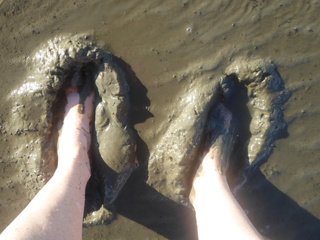


The Weser bicycle route brought us right through the impressive harbour of Bremerhaven, the fourth biggest harbour in Europe, with cruise ships, container ships and hundreds of cars destined for all corners of the world lined up on the wharf.


Bremen
Our hotel in Bremen was the first place ever that didn’t have space for our bikes. We were directed to a safe city bike storage facility around the corner where we could park them over night in a private box for the nominal price of 1€. This became the norm in the bigger German cities.


Bremen city is well worth checking out. Needless to say the Bremen musicians of Grimm’s Fairy Tales fame have a prime location as does Roland, the city protector proclaiming freedom since 1404. After a wander through the medieval Schnoor neighbourhood, we were pleasantly surprised with a live concert in Town Hall Square, our first since the virus hit Europe. The Australian band “The Wishing Well” did the honours.



Verden
Thomas and Barbara rolled out the red carpet again in Verden, as we explored their delightful home town on the River Aller.



Our first challenge
The stretch to Osnabrück provided the first challenge of the trip. The Teutoburg Forest made us climb all of 200 altitude meters, quite an achievement after all that riding in the plain! Osnabrück is famous for the Peace Treaty of 1648 that brought the 30 Years’ War to an end… and for the lion-poodle statue protecting the cathedral. It’s clear even to the untrained eye, that the artist had never laid eyes on a lion, but his approximation is nonetheless loved by the locals. And, we have to admit, it is kind of cute!



Münster
By our totally unscientific definition, we entered the west of Germany (as opposed to West Germany) in Münster. This is the ultimate bicycle city of Germany. There are bicycles everywhere, and the traffic system provides ample space and safety to cyclists of all ages. A real model it is! Besides that, it is also a beautiful town to wander around until it’s time to rehydrate and have a good feed in one of the many traditional inns.


The Rhur Valley
The Ruhr Valley was a real highlight. What was probably the most polluted area of Europe in the 1970s, is now a thriving cultural and recreational centre taking advantage of the various remnants of Germany’s bygone coal and steel industries. Halden (spoil heaps) offer fabulous panoramic views of the area and are adorned with art installations or integrated into the local mountain bike trails. Former steel works, blast furnaces and gasometers provide the venue for numerous activities including concerts, festivals, museums, rock climbing and even scuba diving. The Emscher Landscape Park encompasses 450 square kilometers and offers bike trails, parks and cultural centres in this unique industrial scenery. The whole area is amazingly green and the smoky chimneys are long gone!




Duisburg
In Duisburg, our friends Elke and Markus exposed us to true German hospitality as they brought us well up to date on local developments. After a spin through the Landscape Park, they introduced us to their latest craze at the Aloha stand-up-paddling (SUP) station. The friendly, welcoming atmosphere, sandy beach and glorious weather made for a real holiday feeling. Elke and Markus treated us to a SUP beginner’s course, which we thoroughly enjoyed. It could even become the start of a new website 😉




A game-changer for Darina!
Darina was a new woman leaving Duisburg! While an enthusiastic fan of camping, 4am was often a critical moment when she had to brave the elements and head to the toilet. The inconvenience of this, especially in wet, miserable weather, was enough to curtail Darina’s enjoyment of that last cup of tea before snuggling up for the night. That was, until Elke presented her with a urinella! Weighing all of 17g, this little silicon device enables ladies to do the necessary into a bottle in the comfort of their own tent. Liberation! When choosing a bottle for emergencies, ladies, be warned that the capacity of a female bladder can be up to 800ml 😉

The Rhine
Following the Rhine, we had lunch in Düsseldorf and a pleasant afternoon and evening in Cologne. With the concentration of Irish pubs in both cities, Darina concluded that German beer can’t be any great shakes!



The Ahr Valley
The next day, we enjoyed lunch in the former West German capital of Bonn before turning west again into the Ahr Valley. This was a very picturesque introduction to the Eifel mountain range with rocky overhangs and vineyards interspersed with lovely villages of half-timbered houses. The bike route is an easy spin on a former train line.




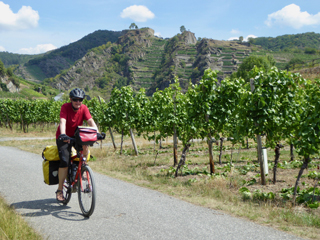
Our second challenge!
Just a hop, skip and jump from Belgium, the steep climb up to Nürburg, famous for its Formula One racecourse, made us work up a sweat like never before on this trip. Challenge number two! But a shower and a pizza later, all was forgiven.



Lakes a dime a dozen
Volcanic lakes, known as Maars, are a local geographical peculiarity in the area. Created from small explosions that occur when ground water makes contact with hot magma or lava, they are pleasant places for a swim and a little hike. A few steep hills later we were in Trier on the River Moselle, which forms the border between Germany and Luxembourg.

The Roman influence
Trier was our second highlight and certainly our favourite city on this trip. A Roman stronghold built to supply its garrisons on the Rhine but set back far enough to be safe, it became the seat of Cesar in the later stages of the Roman Empire. The Porta Nigra is the most famous landmark, and there is an abundance of Roman sites and artefacts around about. It’s also Karl Marx’s hometown.
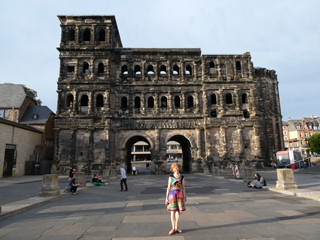




On the Moselle
The Moselle bike route is one of the most famous river routes in Germany, and it certainly didn’t disappoint. Meandering through more vineyards, cutesy villages and castles than you could imagine, it took us a full three days to reach the confluence with the Rhine at Koblenz. We’ll let the pictures speak for themselves.





Another Irish connection!
This area is incidentally home to the famous Blue Nun white wine that religiously graced every Irish Christmas dinner table in the 1970s and 1980s. Marketed as the wine that suited any meal or course, it was the first German wine to have international success.



The Romantic Rhine Route
From the adorable city of Koblenz until Wiesbaden, we were on the Romantic Rhine Route where castles, charming towns full of half-timbered houses, sandy beaches and riverine islands please the eye. And did we mention vineyards?






Frankfurt
Following the Main upriver, we arrived in Frankfurt all set for a rest day as temperatures hit 38°C. The small old town boasting the birth house of Goethe is soon to be overshadowed by its New York City Factor skyscrapers earning Frankfurt its alternative name: Mainhattan!





On the Tauber
We stayed on the River Main as far as Aschaffenburg before climbing through the Spessart forest to the Tauber Valley. Now, the Tauber bike route is yet another one that ticks all the boxes making it a viable contender for the most popular cycling route in Germany, i.e. cute villages with half-timbered houses, city walls and medieval castles. Unfortunately, the weather was a tad overcast, so the pictures don’t do justice to this fabulous route.




Rothenburg ob der Tauber is a real open-air museum and certainly one of those calendar pictures you have admired in the past. While the city walls and medieval buildings contribute to its must-see status, in our humble opinion, their local culinary claim to fame does not quite reach the same standard. Snowballs, as they are called, are strips of shortcrust pastry formed loosely into fist-sized balls, deep-fat fried and then amply dusted with icing sugar. The result is a pitiful, overrated dust storm that has a shelf life of about eight weeks! Even for a hungry cyclist, a once-in-a-lifetime experience will certainly suffice!




Stuttgart
Our friend Anke in Stuttgart was another great ambassador of German hospitality. Once Kurt had his visit to the dentist and Darina had completed her search for Banksy’s shredded Girl with balloon painting, she showed us around her home town. It was a pleasant stroll through spacious squares, busy shopping streets and castle gardens, ending up with Maultaschen (the local ravioli-type speciality) on a deckchair under a tree, watching the world roll by.



The last leg
With some Neckar, Erms, Grosse Lauter and Danube, we had another four rivers to follow before cutting across extensive orchards to Friedrichshafen on Lake Constance. Once we got closer, we had a blimp guiding us two wise cyclists like the Star of Bethlehem. It was in Friedrichshafen that Zeppelin built the first solid rump blimp, and the impressive Zeppelin museum outlines the fascinating history of this balloon and airplane hybrid. This was our last town in Germany, and we had just enough time for a spaghetti ice-cream sundae before boarding the ferry to Romanshorn in Switzerland and climbing our last hill up to St Gallen.




Looking back, it is clear that on this 2,000 km stretch we covered enough ground for at least three different trips. Splitting it up would have afforded us more time in some lovely places, and we could have admired each and every one of the many half-timbered houses!
What we can say is that the traffic was usually very accommodating, we ate very well, Kurt collected enough beer pics for a slide show, and Darina got to taste strange brews like Spezi: Orange lemonade mixed with Cola.

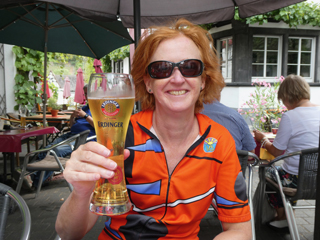

Food
Speaking of food, we loved the Fischbrötchen (herring fish buns) up North, which were a handy snack just the right size for a sunny spell! Fried fish with mustard sauce was typical on the coast, and fried potatoes with bacon bits accompanied most meals. Another northern speciality is Labskaus, a right concoction of corned beef, mashed potatoes and onion mixed together and garnished with beetroot, gherkin, herring and a fried egg. Invented by seamen to make meat past its best-before date more palatable, the dish became known by the Liverpudlians as scouse, which is thought to be the origin of their nickname.


Once you’re away from the coast, food becomes more meat based. One particular speciality we liked was Himmel und Erde (Heaven and Earth): black pudding, mashed potatoes, fried onions and apple purée. Have you noticed? – not a mention of sauerkraut or sausages! Well, we were forever on the lookout and beyond one dish on the menu in Trier and a Currywurst snack in Duisburg, our menu was free of the unmentionables! Summer is not the season, apparently. Take note, Katie 😉 Oh! and the wonderful German tradition of afternoon Kaffee und Kuchen (coffee and cake) is definitely not one to miss.







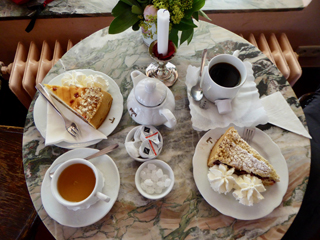
The locals
Despite Covid-19 distancing, we did get the chance to engage with the locals throughout. We found them to be a very hospitable, outgoing, extroverted and humorous bunch that call a spade a spade!



The verdict!
As far as the Coronavirus goes, it didn’t bother us very much. The mask became a routine, and nobody used our many address slips to warn us of a possible infection.
Germany may not have offered the desert steppes, challenging mountain ranges and yurt camps of Kyrgyzstan, but it certainly provided safe, dedicated cycle routes in and out of charming medieval villages, and our three-man tunnel tent served us well!


